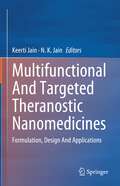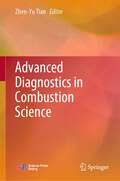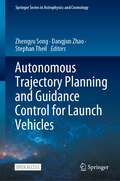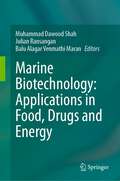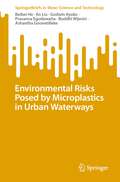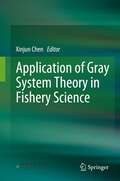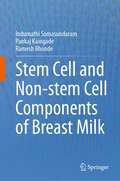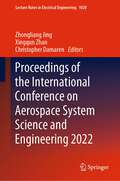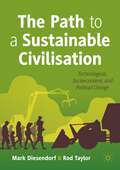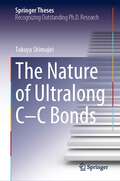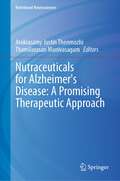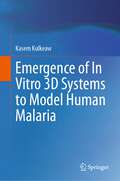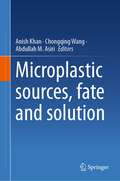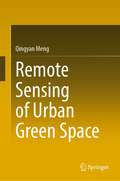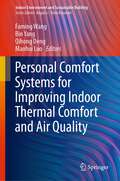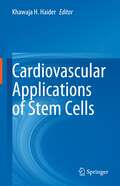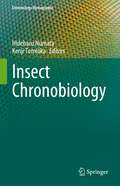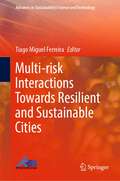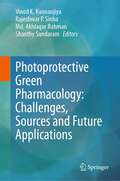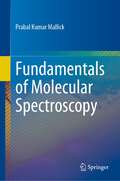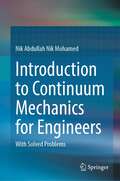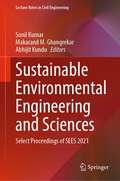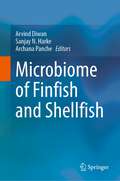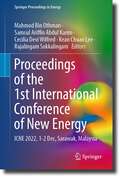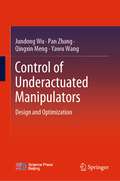- Table View
- List View
Multifunctional And Targeted Theranostic Nanomedicines: Formulation, Design And Applications
by Keerti Jain N. K. JainThis book discusses approaches based on multifunctional and targeted theranostic nanomedicines for improving diagnosis and drug delivery. It explores nanomedicines based on nanocarriers like liposomes, ethosomes, niosomes, polymeric nanoparticles, lipidic nanoparticles, metallic nanoparticles, micelles, dendrimers, quantum dots, carbon-based nanomaterials including carbon nanotubes, carbon dots, carbon quantum dots, graphene oxide, and fullerene. This book reviews designing, conjugation, optimization, formulation and development, and scale-up of multifunctional and targeted theranostic nanomedicines. It examines major challenges in developing nanomaterials that can be applied to nanomedicine with high biocompatibility and biodegradability for diagnostic and therapeutic purposes. Lastly, it addresses the most promising approaches at both commercialization and regulatory steps for bringing theranostic nanomedicine from research laboratories to clinics for patient use.
Advanced Diagnostics in Combustion Science
by Zhen-Yu TianThis textbook, supported by the Textbook Publishing Center of University of Chinese Academy of Sciences, provides a fundamental introduction to advanced diagnostics techniques for graduate students majoring in combustion science, chemistry, and chemical engineering-related subjects. The textbook provides an overview with respect to the spectroscopic methods in advanced diagnostics techniques such as gas chromatography/mass spectrometry, thermochemical analysis, Raman scattering, and nuclear magnetic resonance. It then describes the comprehensive basic theory, equipment structure, and testing methods of diagnostic techniques and summarizes the analysis methods commonly used in combustion chemical reaction processes. This can provide graduate students with important guidance and comprehensive understanding of diagnostics techniques before performing physics and chemistry experiments. In addition, it provides an introduction into using common mathematical and graphics packages for students to acquire and practice the tools to comply with international standards. The textbook is concise and illustrative and includes hot issues and current progress of diagnostics. In addition, exercises and questions are included at the end of each chapter for students to practice and gain hands-on experience. Given its scope, the textbook is of great benefit to graduate students in combustion chemistry and engineering and other related areas such as environmental science, optical engineering, and thermal science and is also beneficial for researchers with interdisciplinary backgrounds.
Autonomous Trajectory Planning and Guidance Control for Launch Vehicles (Springer Series in Astrophysics and Cosmology)
by Zhengyu Song Dangjun Zhao Stephan TheilThis open access book highlights the autonomous and intelligent flight control of future launch vehicles for improving flight autonomy to plan ascent and descent trajectories onboard, and autonomously handle unexpected events or failures during the flight. Since the beginning of the twenty-first century, space launch activities worldwide have grown vigorously. Meanwhile, commercial launches also account for the booming trend. Unfortunately, the risk of space launches still exists and is gradually increasing in line with the rapidly rising launch activities and commercial rockets. In the history of space launches, propulsion and control systems are the two main contributors to launch failures. With the development of information technologies, the increase of the functional density of hardware products, the application of redundant or fault-tolerant solutions, and the improvement of the testability of avionics, the launch losses caused by control systems exhibit a downward trend, and the failures induced by propulsion systems become the focus of attention. Under these failures, the autonomous planning and guidance control may save the missions. This book focuses on the latest progress of relevant projects and academic studies of autonomous guidance, especially on some advanced methods which can be potentially real-time implemented in the future control system of launch vehicles. In Chapter 1, the prospect and technical challenges are summarized by reviewing the development of launch vehicles. Chapters 2 to 4 mainly focus on the flight in the ascent phase, in which the autonomous guidance is mainly reflected in the online planning. Chapters 5 and 6 mainly discuss the powered descent guidance technologies. Finally, since aerodynamic uncertainties exert a significant impact on the performance of the ascent / landing guidance control systems, the estimation of aerodynamic parameters, which are helpful to improve flight autonomy, is discussed in Chapter 7. The book serves as a valuable reference for researchers and engineers working on launch vehicles. It is also a timely source of information for graduate students interested in the subject.
Marine Biotechnology: Applications in Food, Drugs and Energy
by Muhammad Dawood Shah Julian Ransangan Balu Alagar Venmathi MaranThis contributed volume covers the applications of marine biotechnology for food, drugs and energy production using marine resources. It introduces many aspects of marine biotechnology, including bioenergy, pharmaceutical development, food security from mariculture, pollution handling, legal issues and conflicts. Information in the book is accompanied by clear images, flow charts, quantitative and qualitative data. Marine biotechnology is essential for realizing the previously untapped potential of marine bio-resources. These resources are used to develop innovative goods and procedures that aid in the global management of food, energy, and disease management. The development of innovative tools and solutions for more sustainable marine environmental management is another important section of this title. This reference book is of interest to teachers, researchers, and climate change scientists. It serves as an additional reading material for college, undergraduate, and graduate students of marine science and aquaculture. This is also a good research guide for food and fishing industry scientists.
Environmental Risks Posed by Microplastics in Urban Waterways (SpringerBriefs in Water Science and Technology)
by Beibei He An Liu Godwin Ayoko Prasanna Egodawatta Buddhi Wijesiri Ashantha GoonetillekeThis book presents comprehensive knowledge regarding the spatial and temporal distributions, influential factors, interactions with coexisting contaminants, migration behavior, and environmental risk posed by microplastics (MPs) in urban waterways. It provides a novel theoretical approach for the combined risks from MPs and coexisting contaminants, and advanced three-dimensional modeling techniques for different MPs’ dispersal and transport behaviors in urban waterways. Additionally, this book presents a scientifically robust investigation on the correlations between various influential factors and heterogeneity in relation to MP presence in river systems. The new knowledge presented would be of particular interest to readers such as urban water management professionals, urban plastic waste regulators, decision-makers, urban planners, and water environment quality model developers, as it provides practical solutions and recommendations for plastic-polluted river quality improvement from a risk management perspective.
Application of Gray System Theory in Fishery Science
by Xinjun ChenThis book reviews the gray system and combines its latest research results in fishery science. The chapters cover the basic concept and theory of gray system, original data processing and gray sequence generation, gray correlation analysis, gray cluster analysis, gray system modeling, gray prediction, gray decision-making, and gray linear programming. The theory of gray system is a new cross-sectional discipline founded in 1982 by Professor Deng Julong, a well-known scholar in China. In recent decades, it has not only been deepened and expanded in theory but also widely used in the fields of society, economy, ocean, agriculture, fishery, and other fields, and made a series of significant scientific achievements. These have laid the foundation for the important position of the gray system theory. Due to the great uncertainty of the fishery resources and the fishery environment involved in the fishery science system, which is completely different from the natural resources on the land, the data and information belong to the category of “poor information”, and the variability and uncertainty are greater than other natural resources. As an extremely effective analytical method and tool, gray system theory has been applied increasingly in fishery science. The book is developed based on well-read and practical literature and will help scientists and research units engaged in scientific research and teaching in fishery science and related fields to develop new research methods and tools.
Stem cell and Non-stem Cell Components of Breast Milk
by Indumathi Somasundaram Pankaj Kaingade Ramesh BhondeThis book reviews the cellular and non-cellular components of human breast milk and their contribution to infant growth and development. It also discusses various cellular growth factors in breast milk, including stem cells and their significance in promoting optimal growth, immunity and regeneration in neonates and in mitigating several neonatal diseases. Further, the book examines variations in the macronutrient concentrations of human milk in different lactation stages and maternal factors. It also describes the potential of antimicrobial proteins/peptides in human milk to provide innate immunity to infants. Lastly, it explores the regenerative therapeutic applications of breast milk cells in feeding infants.
Proceedings of the International Conference on Aerospace System Science and Engineering 2022 (Lecture Notes in Electrical Engineering #1020)
by Zhongliang Jing Xingqun Zhan Christopher DamarenThe book collects selected papers presented at the 6th International Conference on Aerospace System Science and Engineering (ICASSE 2022), organized by Shanghai Jiao Tong University, China, and hosted by University of Toronto, Canada in July 2022. It provides a forum for experts in aeronautics and astronautics to share new ideas and findings. ICASSE conference has been organized annually since 2017 and host in Shanghai, Moscow, and Toronto in turn, where the three regional editors of journal Aerospace Systems are located.This book presents high-quality contributions in the subject area of Aerospace System Science and Engineering, including topics such as: Trans-space vehicle systems design and integration, Air vehicle systems, Space vehicle systems, Near-space vehicle systems, Opto-electronic system, Aerospace robotics and unmanned system, Aerospace robotics and unmanned system, Communication, navigation and surveillance, Dynamics and control, Intelligent sensing and Information fusion, Aerodynamics and aircraft design, Aerospace propulsion, Avionics system, Air traffic management, Earth observation, Deep space exploration, Bionic micro-aircraft/spacecraft.
The Path to a Sustainable Civilisation: Technological, Socioeconomic and Political Change
by Mark Diesendorf Rod TaylorThe Path to a Sustainable Civilisation shows that we have unwittingly fallen into an existential crisis of our own making. We have allowed large corporations, the military and other vested interests to capture governments and influence public opinion excessively. We have created a god called ‘the market’ and allowed our most important decisions to be made by this imaginary entity, which is in fact a human system controlled by vested interests. The result has been the exploitation of our life support system, our planet, and most of its inhabitants, to the point of collapse. This book argues that the way out of our black hole is to build social movements to apply overwhelming pressure on government and big business, weaken the power of vested interests and strengthen democratic decision-making. This must be done simultaneously with action on the specific issues of climate, energy, natural resources and social justice, in order to transition to a truly sustainable civilisation.
The Nature of Ultralong C–C Bonds (Springer Theses)
by Takuya ShimajiriThis book focuses on the creation and demonstration of a carbon–carbon (C–C) single bond beyond 1.8 Å and on elucidation of its unique nature. C–C single bond is one of the most fundamental concepts in organic chemistry. The elucidation of its nature is important for further understanding chemical phenomena. The nature in the extreme state of C–C single bond is still unexplored because of the instability of compounds. In terms of its bond length, the limit had been predicted around 1.8 Å based on the experimental and theoretical studies. This book describes a first example of a C–C single bond beyond 1.8 Å by employing the original intramolecular core-shell strategy to make a weak and elongated bond stable enough. The presence of such an elongated bond was demonstrated by experimental and theoretical studies. The bond length changes could affect physical properties such as optical absorption and redox potential. Furthermore, its unique "flexibility" was discovered. This book benefits the chemists with deeper understanding of the covalent bonding.
Nutraceuticals for Alzheimer's Disease: A Promising Therapeutic Approach (Nutritional Neurosciences)
by Arokiasamy Justin Thenmozhi Thamilarasan ManivasagamThis book reviews the potential effect of diet modification, lipids, and carbohydrate consumptions, vitamin supplementation, antioxidants, and nutraceuticals in the prevention and management of Alzheimer's disease. The initial chapter of the book presents the pathophysiological mechanisms, risk factors, genetic predisposition, disease diagnosis, pathology, and current treatment strategies against Alzheimer's disease. It also highlights recent developments in exploring novel compounds for the prevention and treatment of Alzheimer's disease. Subsequently, it highlights the therapeutic effect and regulation of molecular targets by natural compounds. The book discusses the potential of natural compounds in inhibiting the formation and deposition of Aβ peptides. It examines the natural compounds in modulating intracellular signaling molecules and enzymes involved in the pathogenesis of Alzheimer's disease. In summary, this book helps understand the role of natural compounds as a therapeutic approach in amelioration and preventing detrimental effects of Alzheimer's disease.
Emergence of In Vitro 3D Systems to Model Human Malaria
by Kasem KulkeawThis book illustrates the importance and advances of the disease model for malaria, a globally affected public health problem. This book provides comprehensive information on the malaria biology in a liver and all in vitro platforms for liver-stage malaria, including principles, protocols, applications for disease modeling and drug screening, and their limitations. The initial chapter describes the basis of stem cells in liver generation during development and in adults. The subsequent chapters highlight recent and emerging advances in liver organoid and liver-on-a-chip in modeling malaria. The book presents current protocols and methods to generate liver organoid and liver-on-a-chip together with their advantages and limitations. Toward the end, the book examines the humanized mouse model of liver-stage malaria using ectopic artificial livers regarding novel readout modalities. The recent advancement and challenges in combining liver-on-a-chip technology with biosensors are highlighted for assessing hepatocyte development viability and functions. The book elucidates the potential of these 3D models to understand the biological complexity of cellular and molecular mechanisms involved in Plasmodium development in the liver, toolboxes to investigate parasite deployment in the 3D models, and to implement in drug discovery. Finally, the book discusses the future directions and challenges in the applications of liver organoids and liver on-chip in the biology of live-stage malaria. This book is helpful for researchers and scientists in the field of parasitology, cell biology, tissue engineering, and pharmacology.
Microplastic sources, fate and solution
by Anish Khan Chongqing Wang Abdullah M. AsiriThis book provides an overview of the sources, occurrence, fate and solution of microplastics. Microplastics in sediment and soil environment have been only scarcely surveyed, and no profound discussion on microplastics removal is summarized until this book. Here we focus on sharing clear schematic information and the book sufficiently supports important microplastic topics: such as microbial network, microplastic toxicology and accumulation, agricultural plastics, nylon microplastics, polystyrene microplastics, polyethylene microplastics and many more. The book mainly provides an overview of recent advances in knowledge of sources, occurrence, distribution, chemical behavior and ecological threats while it also presents information related to feasible solutions for microplastic pollution management. This comprehensive resource will be valuable up-to-date knowledge for environmental scientists, ecotoxicologists, ecologists, marine biologists, environmental chemists in the academic field and this book is intended to be beneficial information for environmental managers, water suppliers, wastewater treatment, plastics manufacturer, and policy makers as well.
Remote Sensing of Urban Green Space
by Qingyan MengThis book presents a systematic study of urban green space remote sensing from multi-dimensional and multi-scale technologies. On the basis of introducing the connotation, science and application value of urban green space, this book focuses on the two-dimensional and three-dimensional information extraction technology of urban vegetation, two-dimensional and three-dimensional measurement technology of urban green space and multi-scale perception technology and discusses the remote sensing evaluation method of urban green space. By exploring the technical advantages of ‘satellite remote sensing + aerial remote sensing + near-ground remote sensing’, urban green space remote sensing promotes the development of urban vegetation research from two-dimensional to three-dimensional observation, so that the quantity, quality and human perception of urban vegetation can be measured. In each chapter, an individual technology/method is introduced, and several cases are cited to demonstrate its practical application. This book offers a valuable reference guide for practitioners in urban planning, landscape greening, environmental protection and urban management, as well as teachers and graduate students engaged in urban remote sensing research.
Personal Comfort Systems for Improving Indoor Thermal Comfort and Air Quality (Indoor Environment and Sustainable Building)
by Faming Wang Bin Yang Qihong Deng Maohui LuoThis book first describes fundamental knowledge on human thermal comfort, adaptive thermal comfort, thermal comfort in sleeping environments, modeling of human thermal comfort, and thermal comfort assessment using human trials. Next, it presents an in-depth review of concept progress and evaluation of various personal comfort system, summarizes important findings and feasible applications, current gaps as well as future research needs. The seven chapters included in this section are task/ambient conditioning systems, personalized ventilation systems, electric fans, personal comfort systems, thermoelectric systems, personal thermal management systems, and wearable personal thermal comfort systems. This book provides valuable guidance for personal comfort system design and further improvement on the personal comfort performance. It will be a valuable resource for academic researchers, engineers in industry, and government regulators in the field of sustainable buildings and built environment.
Cardiovascular Applications of Stem Cells
by Khawaja H. HaiderThe book covers multifarious aspects of stem cell-based therapy for cardiovascular diseases. In addition to stem cells from different sources for cell-based therapy, it covers stem cell organoids and stem cell-derived exosomes in regenerative medicine. The book also encompasses advances in state-of-the-art infrastructure to improve the maturation aspects of pluripotent stem cells-derived cardiomyocytes using a novel scaffold-based cell culture system for cell delivery in experimental animal models and clinical settings. Besides the use of mesenchymal stem cells, the book includes chapters on the use of cardiac progenitor cells (CPCs), microtissue implantation, use of PSCs for valvulopathies, application of de-cellularized organ arrays as natural scaffolds for cardiac tissue engineering, use of epicardial stem cells, and skeletal myoblasts in cell-based therapy for myocardial regeneration. Besides the cell-based therapy approach, the book also reviews the stem cell-derived exosomes, their characteristics, and engineering strategies to enhance their therapeutic potential via targeting and drug loading and use in disease models. Additionally, the book also discusses the latest research on injectable hydrogels for cardiovascular regeneration and how hydrogel-based delivery protects the cells and their retention post-engraftment in the heart, a problem, which significantly reduces the efficacy of cell-based therapy.
Insect Chronobiology (Entomology Monographs)
by Hideharu Numata Kenji TomiokaThis book reviews the physiological mechanisms of diverse insect clocks, including circadian clock, lunar clock, tidal clock, photoperiodism, circannual rhythms and others. It explains the commonality and diversity of insect clocks, focusing on the recent advances in their molecular and neural mechanisms. In the history of chronobiology, insects provided important examples of diverse clocks. The first report of animal photoperiodism was in an aphid, and the time-compensated celestial navigation was first shown in the honeybee. The circadian clock was first localized in the brain of a cockroach. These diverse insect clocks also have some common features which deserve to be reviewed in a single book. The central molecular mechanism of the circadian clock, i.e., the negative feedback loop of clock genes, was proposed in Drosophila melanogaster in the 1990s and later became the subject of the Nobel Prize in Physiology or Medicine in 2017. Thereafter, researches on the molecular and neural mechanisms in diverse insect clocks other than the Drosophila circadian clock also advanced appreciably. Various new methods including RNAi, NGS, and genome editing with CRISPR-Cas9 have become applicable in these researches. This book comprehensively reviews the physiological mechanisms in diverse insect clocks in the last two decades, which have received less attention than the Drosophila circadian clock. The book is intended for researchers, graduate students, and highly motivated undergraduate students in biological sciences, especially in entomology and chronobiology.
Multi-risk Interactions Towards Resilient and Sustainable Cities (Advances in Sustainability Science and Technology)
by Tiago Miguel FerreiraFor years, researchers have studied the risks of individual natural hazards in urban areas. However, the impact of multiple hazards has not yet received widespread attention in research and urban management practice, which is a significant gap in the current climate change context. This book aims to contribute to filling that gap by examining the process of identifying, assessing, and managing multi-hazard risks in urban areas. From identifying and assessing the vulnerability of the elements exposed to the impact of natural hazards, including earthquakes, floods, fires, and landslides, this book covers all the critical stages of multi-hazard risk assessment and management in a climate change context. The concepts and approaches discussed in the book are applied to the Lisbon Metropolitan Area, a dynamic and thriving metropolis, allowing readers to see those theories applied in a real setting. In addition to providing a solid theoretical foundation, this book offers practical guidelines for conducting risk assessment at the metropolitan scale, which makes it a valuable resource for researchers, practitioners, and decision-makers interested in understanding and managing multi-hazard risks in urban areas.
Photoprotective Green Pharmacology: Challenges, Sources and Future Applications
by Vinod K. Kannaujiya Rajeshwar P. Sinha Md. Akhlaqur Rahman Shanthy SundaramThis book illustrates the role of photoprotective and radioprotective metabolites from natural sources. Various classes of radioprotective metabolites derived from cyanobacteria, algae, fungi, bryophytes, pteridophytes, gymnosperms, and higher plants have been explained to reinforce the current knowledge in this field. In addition, the book elucidates the potential applications of these metabolites in pharmaceutics, cosmetics, and biomedical sciences that will help develop commercial products in modern anti-radiation therapeutics. Topics such as stress tolerance environmental strategies, evolutionary tendency, and biosynthetic route of radioprotective compounds for cost-effective large-scale industrial production of the metabolites are also covered in the book. This book will add to the understanding of radioprotective mechanisms and curative measures for various deleterious diseases leading to cancer development. This volume also offers the latest insights into current and upcoming issues that arise from solar and atomic radiations and their amelioration by inherent radioprotective mechanisms of green plants. This book benefits readers from academia, industry, colleges, and research students to better understand the impacts of various radiations and the development of radioprotective green compounds.
Fundamentals of Molecular Spectroscopy
by Prabal Kumar MallickThis book presents detailed aspects of different fields of molecular spectroscopy. It consists of eleven chapters starting from the Born–Oppenheimer approximation and its relevance to various spectra to some topics on nonlinear spectroscopy through rotational, vibrational, Raman, and electronic spectroscopy, group theoretical application, nuclear magnetic resonance, electron spin resonance, nuclear quadrupole resonance, and Mossbauer spectroscopy. The intention is to present a good background of the theoretical aspects of the concerned fields which will help the readers to understand the subject firmly and apply them to their own fields according to their needs. For this purpose, several problems have been worked out to make the readers understand how the theories are applied in the relevant practical cases. In this book, it is presumed that the readers are well acquainted with the fundamentals of the basic subjects of physics, for example, mathematical methods, classical mechanics, quantum mechanics, statistical mechanics, and electrodynamics. The purpose of writing is not only to bring a wider field in a single book but also to develop the theories starting from the fundamentals and also from the simple to the final forms through fairly elaborate powerful techniques so that the readers become self-sufficient and apply them accordingly. Since this book covers most of the major fields of molecular spectroscopy, it reduces the work of searching several publications and serves the purpose of getting detailed deductive pictures of various aspects of the subject in a single publication.
Introduction to Continuum Mechanics for Engineers: With Solved Problems
by Nik Abdullah MohamedThis textbook provides an overview of the fundamental concepts in continuum mechanics for application in real material behavior analysis. The contents cover basic topics such as Kinematics—the motion of any material point representing a material body using the Lagrangian and Eulerian approaches; stress tensors—stress analysis of material bodies experiencing small deformations; mathematical modeling of material properties in continuum mechanics; balance principles—transfer of specific mechanical properties from a system to its environment or vice-versa through the system boundary. The textbook also contains pedagogical elements such as worked examples and end-of-chapter exercises which are derived from typical engineering problems, and the solution manual so that students can solve computational problems by running simulations on Matlab or Python on their own. This benefits engineering students understand the concept of continuum mechanics for future analysis using finite-element analysis, boundary element method or any other computational methods.
Sustainable Environmental Engineering and Sciences: Select Proceedings of SEES 2021 (Lecture Notes in Civil Engineering #323)
by Sunil Kumar Makarand M. Ghangrekar Abhijit KunduThis book presents the select proceedings of the International conference of Sustainability in Environmental Engineering and Science (SEES) 2021. It presents the latest developments in civil engineering that cover all aspects and challenges in civil engineering, environmental engineering and environmental science. Various topics covered in this book include construction and structural mechanics, building materials, concrete, steel and timber structures, geotechnical engineering, earthquake engineering, and coastal engineering. The volume will be useful for beginners, researchers, and professionals working in the areas of sustainable civil engineering and related fields.
Microbiome of Finfish and Shellfish
by Arvind Diwan Sanjay N. Harke Archana PancheThis book helps us to understand the importance of the microbiome associated with finfish and shellfish inhabiting different locations and varied environmental and biological situations. It covers modern molecular tools for identifying microbiome composition and their precise identification at the species level. The book also covers the molecular structural composition of individual microbes, metabolite resources from microbiome species, their functional properties, and production aspects. Notable, the book covers the microbiome applications in the gut systems of finfish and shellfish to the digestion, nutrition, growth, reproduction, immune system, and vulnerability of the host to diseases. It also reviews diversity and functional properties, relationships with diseases, health status, data on species-specific metagenomics, and probiotic research. It highlights the relevance of microbial communities for the development of new and innovative bio-products to build bio and pharmaceutical industries, including aquaculture. This book is an invaluable source for researchers and professionals involved in fishery science, fisheries and aquaculture, fish biotechnology, and fish microbiology and pathology
Proceedings of the 1st International Conference of New Energy: ICNE 2022, 1-2 Dec, Sarawak, Malaysia (Springer Proceedings in Energy)
by Mahmod Bin Othman Samsul Ariffin Abdul Karim Cecilia Devi Wilfred Kean Chuan Lee Rajalingam SokkalingamThis book presents peer-reviewed articles from the 1st International Conference on New Energy (ICNE 2022), held on 1–2 December at Sarawak in Malaysia. This book highlights the current trends/studies on fundamental of hydrogen technologies and the application of hydrogen as the new sustainable renewable energy. Topics included but not limited to are: hydrogen production, its storage and transportation, and hydrogen utilization. This book contributes in making green hydrogen competitive and ready for a scale up in the 2030s, towards the objective of reaching net zero emissions by 2050
Control of Underactuated Manipulators: Design and Optimization
by Jundong Wu Pan Zhang Qingxin Meng Yawu WangThis book investigates in detail cutting-edge technologies of underactuated manipulator control, which is a frontier topic in robotics that possesses great significance in energy conservation as well as fault tolerance for industrial applications. It is also the crucial technology associated with systems in special environments, including underwater or aerospace environments. So far, the topic of underactuated manipulator control has attracted engineers and scientists from various disciplines, such as applied physics, material, automation and robotics. Pursuing a holistic approach, the book establishes a fundamental framework for this topic, while emphasizing the importance of design and optimization in the control of underactuated manipulators. Chapters of the book cover a wide variety of manipulator systems, including vertical underactuated manipulator, planar underactuated manipulator with first-order nonholonomic constraint, planar underactuated manipulator with second-order nonholonomic constraint and flexible underactuated manipulator. The book is intended for undergraduate and graduate students that are interested in underactuated manipulators, researchers that investigate the design and optimization for controllers of underactuated manipulators and engineers working with underactuated systems.
